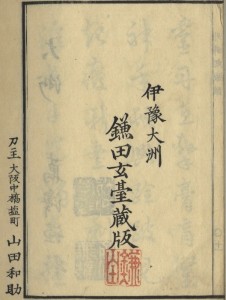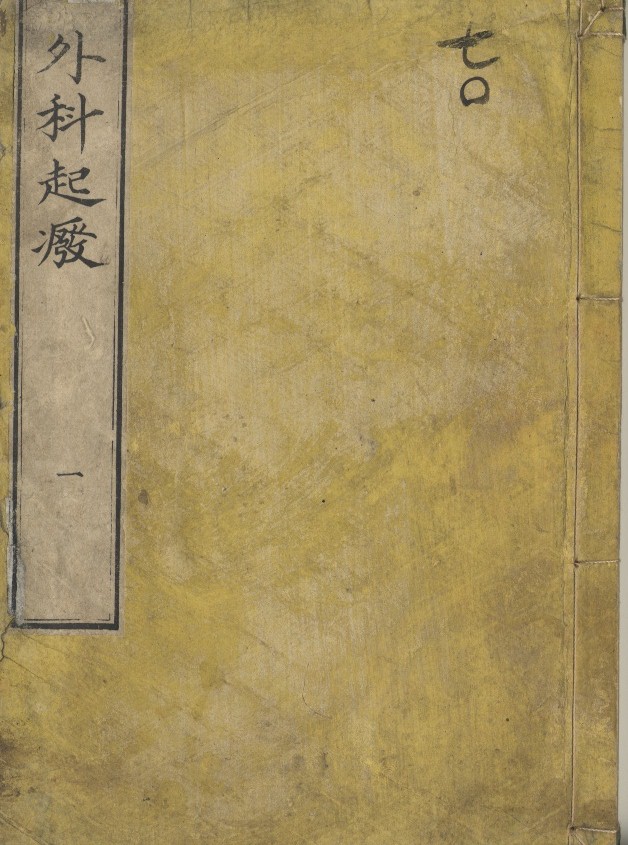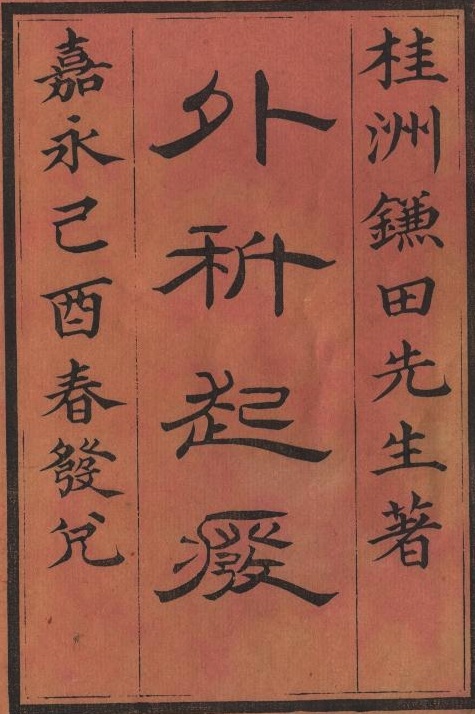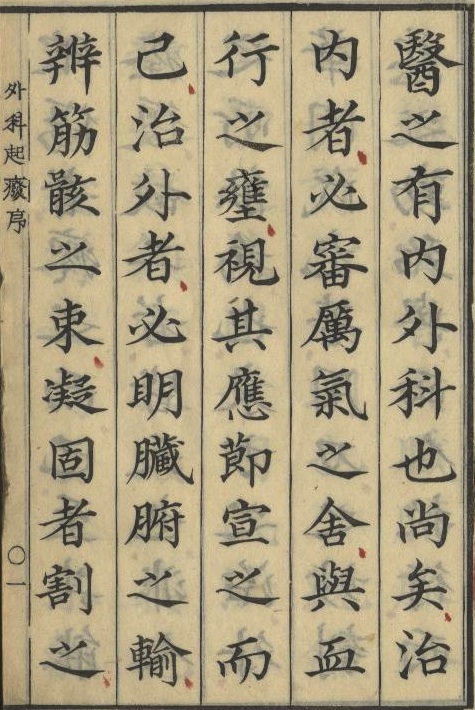
外科起廃 表紙
- 外科起廃 表紙
- 外科起廃 中表紙
- 外科起廃 序文(一部)
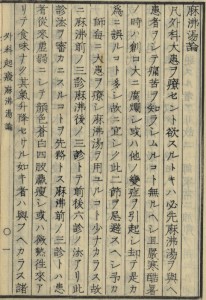 おしなべて、外科的大病を治療する時は、すべての患者において、麻沸湯を与えて苦痛を取るべきです。厳寒の時期、酷暑の時期は、創部の化膿を起こしやすく、また他の合併症を引き起こしやすいため治療に失敗することが多く、この時期は避けるべきです。先生(鎌田玄台)は、大病を治療する時には麻沸湯を投与することが少なくありません。そのため、麻沸湯を投与する際には投与前の三診と投与後の三診として前後六の診断法を行いますが、この診断法を詳細に行うことが第一にすべきことです。麻沸湯投与前の三診とは、(1)患者が以前から虚弱であり、顔色が蒼白で手足がやせ細っており、あるいは微熱を繰り返し、食欲がなく、陰陽の「気」の昇り降りがない者には投与してはならない。
おしなべて、外科的大病を治療する時は、すべての患者において、麻沸湯を与えて苦痛を取るべきです。厳寒の時期、酷暑の時期は、創部の化膿を起こしやすく、また他の合併症を引き起こしやすいため治療に失敗することが多く、この時期は避けるべきです。先生(鎌田玄台)は、大病を治療する時には麻沸湯を投与することが少なくありません。そのため、麻沸湯を投与する際には投与前の三診と投与後の三診として前後六の診断法を行いますが、この診断法を詳細に行うことが第一にすべきことです。麻沸湯投与前の三診とは、(1)患者が以前から虚弱であり、顔色が蒼白で手足がやせ細っており、あるいは微熱を繰り返し、食欲がなく、陰陽の「気」の昇り降りがない者には投与してはならない。
On the use of Mafutsuto
Speaking generally, when a serious surgical illness is operated on, the patient should be administered Mafutsuto to have their pain killed. We should avoid the use of Mafutsuto in conditions of extreme heat or cold, because complications, such as suppuration of surgical wounds, tend to occur more frequently under those conditions, leading to treatment failure. When giving surgical treatments, Gendai Kamata, our teacher, rather frequently administers Mafutsuto. For such patients, we perform six peri-anesthesia diagnoses, of which three are performed before the administration of the Mafutsuto, and three after the administration. Performing those diagnoses in detail is the most important process in the administration of Mafutsuto.
Pre-administration diagnoses are made to assess whether the use of Mafutsuto is appropriate for a patient, and there are three major conditions for which the use of Mafutsuto is contraindicated; (1) if a patient is frail with pale face and wasted limbs, frequenly feverish and having low appetite, or not showing rise and fall of ki of the yingyang (ki means spirit),
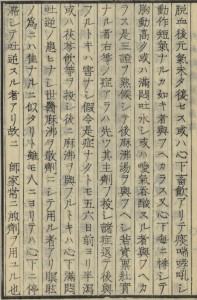 (2)出血後元気を回復せず、あるいは心窩部がつかえる感じがして、痰や咳が出て、動作で息のあがる者には投与してはならない。(3)心臓の動悸が強く、胃がつかえて嘔吐し、あくびや胸やけのあるものには投与してはならない。これらの三つの状態を熟考したその後に 麻沸湯を投与すべきです。壮健な若者でも、上述の症状があれば、まずその症状を治す薬を投与し、諸症状が消退してから麻沸湯を投与する場合は問題ありません。仮にこの症状がなくても、五~六日前より半瀉、あるいは茯苓飲などを投与し、後日麻沸湯を投与すれば、胸のつかえや嘔吐の症状はありません。世間一般の医者の中には麻沸散を散剤にして投与している人がいます。散剤は麻酔のためには良いといわれていますが、人によっては消化管に停滞し、胸やけや嘔吐を発生する場合があるので、先生は常に煎じた麻沸湯を投与していました。
(2)出血後元気を回復せず、あるいは心窩部がつかえる感じがして、痰や咳が出て、動作で息のあがる者には投与してはならない。(3)心臓の動悸が強く、胃がつかえて嘔吐し、あくびや胸やけのあるものには投与してはならない。これらの三つの状態を熟考したその後に 麻沸湯を投与すべきです。壮健な若者でも、上述の症状があれば、まずその症状を治す薬を投与し、諸症状が消退してから麻沸湯を投与する場合は問題ありません。仮にこの症状がなくても、五~六日前より半瀉、あるいは茯苓飲などを投与し、後日麻沸湯を投与すれば、胸のつかえや嘔吐の症状はありません。世間一般の医者の中には麻沸散を散剤にして投与している人がいます。散剤は麻酔のためには良いといわれていますが、人によっては消化管に停滞し、胸やけや嘔吐を発生する場合があるので、先生は常に煎じた麻沸湯を投与していました。
(2) if a patient does not readily regain strength after a hemorrhagic event, or is feeling an epigastric fullness, coughing and/or expelling sputum, and experiences shortness of breath upon exertion, (3) if a patient feels strong palpitation, frequently feels fullness in stomach, and frequently yawns, experiences a heartburn, or vomits. The patient should be assessed carefully for the presence of any of the above three conditions, and then Mafutsuto can be used. If any of those conditions is present, the patient should receive a treatment for it first, and Mafutsuto can be administered upon its resolution. Even if a patient is young and naturally sturdy, the presence of above-mentioned conditions merits a prior treatment. Furthermore, even if a patient does not have those conditions, it is recommended to give Hannsya or Fureiin (they are both oriental medicines) 5 to 6 days prior to administration of Mafutsuto, to prevent the patient from feeling stomachfullness or vomiting when under anesthesia.
There are many docters who use Mafutsusan, an anesthetic in a powder form, boiled extract of which is Mafutsuto (san in Mafutsusan means “powder”, whereas to in Mafutsuto means “soup”). The powder form is said to be stronger than the extracted form, but the powder form tends to remain longer in the intestinal tract and might cause heartburn and vomiting in some patients. Therefore, our teacher always uses the extracted form.
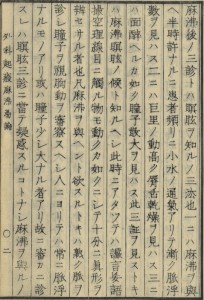 麻沸湯投与後の三診とは、麻酔が効いているかどうかを知る三つの診察法です。一に、麻沸散を与えて1時間ほどで、しきりに尿意を催し、脈は「浮」で「数」となる。二に、巨里の動きが強くなり、唇や舌が乾燥する。三に、顔は酒に酔ったようになり、瞳孔は散大する。この三つの状態を確認すれば麻酔されたと認識してもよい。このときには、うわ言を言ったり、眼の焦点が合わず、宙をみたり、目に映るものが動くように見え、普通の状態ではないように見える。おしなべて、麻沸湯を投与しようとする時は、脈、瞳孔、心音を十分診察すべきです。人によっては常に脈が速い者、瞳孔が小さい者がいますが、術前からよく診ていれば、麻沸湯投与後の三診において迷うことはありません。
麻沸湯投与後の三診とは、麻酔が効いているかどうかを知る三つの診察法です。一に、麻沸散を与えて1時間ほどで、しきりに尿意を催し、脈は「浮」で「数」となる。二に、巨里の動きが強くなり、唇や舌が乾燥する。三に、顔は酒に酔ったようになり、瞳孔は散大する。この三つの状態を確認すれば麻酔されたと認識してもよい。このときには、うわ言を言ったり、眼の焦点が合わず、宙をみたり、目に映るものが動くように見え、普通の状態ではないように見える。おしなべて、麻沸湯を投与しようとする時は、脈、瞳孔、心音を十分診察すべきです。人によっては常に脈が速い者、瞳孔が小さい者がいますが、術前からよく診ていれば、麻沸湯投与後の三診において迷うことはありません。
Three post-administration diagnoses are made while the anesthesia is induced, in order to assess whether the patient is adequately anesthesized. Three conditions indicate the adequacy of anesthesia: (1) if the patient experiences urinary urgencies, and exhibits the pulse that is “floating” (palpable upon light compression of the artery, but not upon strong compression) and “numbered” (tachycardia), (2) if the patient’s apex beat becomes stronger, and the skin and the lips lose their turgor, (3) if the patient exhibits flushing, as if under alcohol intoxication, and pupil dilation. If those signs are observed at about one hour after administration of Mafutsuto, you may assume that the patient is adequately anesthesized. At this point, the patient appears to be in an abnormal state, and may exhibit signs of confusion, such as making incoherent speeches or staring blankly at nothing.
When the patient is under Mafutsuto, it is important to monitor changes in the pulse, the pupil size and the heart sounds closely. Some people naturally have fast heart rate or small pupil, but examining the patient carefully prior to anesthesizing helps one to monitor and assess those changes accurately. After being given Mafutsuto, the patient should be laid down in an isolated room with a quiet environment.
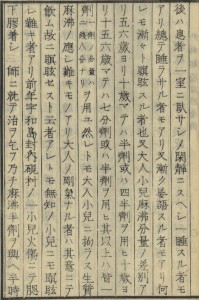 麻沸湯を投与した後は、患者を個室に寝かせ、静かな環境を整えます。眠る者もあれば、一睡もしない者もあります。また、しばらく、うわ言を言う者もいます。いずれも徐々に麻酔状態になります。大人、小児では麻沸湯の投与量に差があります。5、6~10歳までは、大人の四分の一~半剤、10~15,6歳は半剤~七分剤、それ以上の大人は全量、つまり二錢八分(約10g)を煎じて服用させます。しかし、大人、小児に限らず、体質によっては麻沸湯の効きの悪い者もいます。大人で、剛毅な性格ゆえに麻沸湯が効かない者もいるが、小児においても麻沸湯が効きにくい者もいます。昨年、宇和島の硯村の子供が火傷を負い、ほほの下側が癒着したため、先生に治療の依頼が来ました。この時、麻沸湯半剤を投与しましたが、
麻沸湯を投与した後は、患者を個室に寝かせ、静かな環境を整えます。眠る者もあれば、一睡もしない者もあります。また、しばらく、うわ言を言う者もいます。いずれも徐々に麻酔状態になります。大人、小児では麻沸湯の投与量に差があります。5、6~10歳までは、大人の四分の一~半剤、10~15,6歳は半剤~七分剤、それ以上の大人は全量、つまり二錢八分(約10g)を煎じて服用させます。しかし、大人、小児に限らず、体質によっては麻沸湯の効きの悪い者もいます。大人で、剛毅な性格ゆえに麻沸湯が効かない者もいるが、小児においても麻沸湯が効きにくい者もいます。昨年、宇和島の硯村の子供が火傷を負い、ほほの下側が癒着したため、先生に治療の依頼が来ました。この時、麻沸湯半剤を投与しましたが、
Some patients fall asleep, some don’t, and some may speak nonsensically. In all cases, the patients gradually go into anesthesia. There is a difference in doses of Mafutsuto for adults and children. The full dose for adults is approximately 10g. For children aged 5 ~ 10, the dose should be about one quarter of that, and for children aged 10~16, the dose should be about a half of that. In all age groups, however, there are individuals who are poorly responsive to Mafutsuto.
For adults, unresponsiveness to Mafutsuto is often attributed to their personal characters, but there are young children who are unresponsive to Mafutsuto. Last year, our teacher had a request for an operation on an adhesion scar on the lower cheek of a small boy, which resulted from a burn. Initially, a half-dose of Mafutsuto was administered, but it failed to achieve anesthesia at one hour after administration.
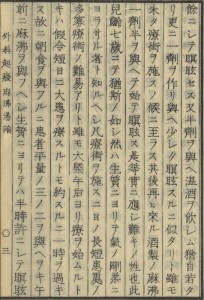 一時間ほど経っても麻酔状態にならず、また半剤を投与し、温めた酒を飲ませたが、まだ効きが悪い。さらに一剤を投与し、少しばかり麻酔状態に入ったようだが、まだ治療を施すほどの状態にまでは至りませんでした。後日、再び来院し、酒で煎じた麻沸湯を一剤半投与して初めて麻酔状態になりました。これは実に、対応しがたい体質です。この小児は七歳でしたが、麻酔が効きにくい体質なのです。このことから、体質により麻酔の効きやすさの有無はあるものの、気質、性格(剛柔)は関係ないことを知っておくべきです。おおよそ、手術を施行する時には、日照時間の長短 手術部位の数、手術の難易度があるとしても、午後より手術を始め、仮に大手術をするとしても、2時間を超えてはいけない。それゆえに、朝食を与える時は、患者の平常の量の三分の二を与え、午前中に麻沸湯を投与すべきです。体質によっては1時間ばかりで麻酔が効く者もあれば、
一時間ほど経っても麻酔状態にならず、また半剤を投与し、温めた酒を飲ませたが、まだ効きが悪い。さらに一剤を投与し、少しばかり麻酔状態に入ったようだが、まだ治療を施すほどの状態にまでは至りませんでした。後日、再び来院し、酒で煎じた麻沸湯を一剤半投与して初めて麻酔状態になりました。これは実に、対応しがたい体質です。この小児は七歳でしたが、麻酔が効きにくい体質なのです。このことから、体質により麻酔の効きやすさの有無はあるものの、気質、性格(剛柔)は関係ないことを知っておくべきです。おおよそ、手術を施行する時には、日照時間の長短 手術部位の数、手術の難易度があるとしても、午後より手術を始め、仮に大手術をするとしても、2時間を超えてはいけない。それゆえに、朝食を与える時は、患者の平常の量の三分の二を与え、午前中に麻沸湯を投与すべきです。体質によっては1時間ばかりで麻酔が効く者もあれば、
Another half-dose was then given, this time with warmed alcohol, and it too failed to achieve anesthesia. Finally, an additional full-dose was given, and it brought the boy into partial anesthesia, but it was deemed inadequate for him to be safely operated on. The patient came back in to our hospital days later, and this time our teacher used one-and-a-half dose of alcohol-extracted Mafutsuto, and this finally put him into adequate anesthesia. Unresponsiveness to Mafutsuto is a diathesis that can be seen even in small children like this patient, who was a 7-year-old, and makes the patient management very difficult. It is important to understand that a patient’s responsiveness, or unresponsiveness, to Mafutsuto is a diathesis stemming from his/her physical property, and not related to his/her personality or temperament.
Generally speaking, the factors influencing the outcome of surgical operations are the daylight length, a number of locations to be operated, and the complexities of the operative procedures. Even in the case of a major operation, the operation should be started in the afternoon, and the duration should never exceed two hours. Therefore, when a patient is allowed to have breakfast on the day of the surgery, he/she should consume only 2/3 of the usual amount, and administration of Mafutsuto should take place during the morning hours. Some patients go into anesthesia within an hour of administration,
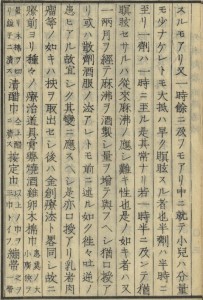 2時間余りかかることもあります。なかでも、小児は投与量が少ないけれども、大抵は早く麻酔が効くものです。基本的には麻沸湯半剤で効果が出るのに1時間、一剤では2時間です。もし、投与後3時間経過しても麻酔が効かなければ、もともと麻酔が効きにくい体質です。このような患者はまた日を改めて、麻沸湯を酒で煎じて、量を増やして与えるべきです。さらに、先生(鎌田玄台)の口伝では、散剤酒服の方法があるが、前述したように、麻沸湯自身が吐き気を催しやすいため、それ相応に対応するべきです(散剤から煎じ薬に)。さらに、先生(鎌田玄台)の口伝では、乳がん、腫瘍の手術の場合、患部を切除し、とり出した後は、金創療法とほぼ同じであるので、手術前にはそれぞれの手術道具、塗り薬、鶏卵、木綿布(患部の縦横大きさを測り、それにみあった木綿を切り鶏卵に浸しておく)、清酢布(木綿布と同様、酢に浸す)、固定布(これを3布という)、
2時間余りかかることもあります。なかでも、小児は投与量が少ないけれども、大抵は早く麻酔が効くものです。基本的には麻沸湯半剤で効果が出るのに1時間、一剤では2時間です。もし、投与後3時間経過しても麻酔が効かなければ、もともと麻酔が効きにくい体質です。このような患者はまた日を改めて、麻沸湯を酒で煎じて、量を増やして与えるべきです。さらに、先生(鎌田玄台)の口伝では、散剤酒服の方法があるが、前述したように、麻沸湯自身が吐き気を催しやすいため、それ相応に対応するべきです(散剤から煎じ薬に)。さらに、先生(鎌田玄台)の口伝では、乳がん、腫瘍の手術の場合、患部を切除し、とり出した後は、金創療法とほぼ同じであるので、手術前にはそれぞれの手術道具、塗り薬、鶏卵、木綿布(患部の縦横大きさを測り、それにみあった木綿を切り鶏卵に浸しておく)、清酢布(木綿布と同様、酢に浸す)、固定布(これを3布という)、
while others take 2 hours or more, depending on their responsiveness to Mafutsuto. Small children achieve anesthesia faster with smaller doses of Mafutsuto, compared to adults. If a patient does not go into anesthesia even at 3 hours after administration, he/she should be considered unresponsive to Mafutsuto. Such patient should have their operation rescheduled for the other date, and be given alcohol-extracted Mafutsuto the next time. For patients unresponsive to Mafutsuto, giving them Mafutusan (powder form) with alcohol is another way to achieve anesthesia. However, as described earlier, the powder form increases the risk of vomiting, and our teacher suggests the use of it be avoided.
According to our teacher, in case of tumor resection, after the resection is completed, the remaining task is to give Kinso treatment (Kinso treatment is a treatment performed on a wound to minimize the risk of wound complications, such as wound infection, and consists of procedures such as bleed control, wound site disinfection, and suturing). Therefore, it is required to have not only the surgical tools, but also ointment, egg, cotton rag, and vinegar-soaked rug, bandage etc. available at the time of the surgery.
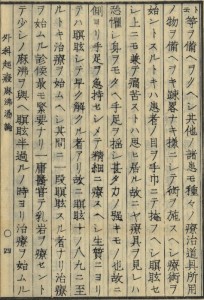 包帯(これを一帯という)等を準備しておくべきです。その他の疾患でもそれぞれの治療道具、必要なものを揃えておき、おろそかにならないようにして手術を施すべきです。手術を始めようとする時は、患者の目を手ぬぐいで覆います。麻酔が効いていても、痛みはあると思い込む場合があるからです。手術道具を見れば恐怖におののき、身もだえし、手足を動かす力はすごいものです。それゆえに、側より手足をしっかり抑制して、緻密に手術を行うべきです。体質によっては麻酔が早く覚める者もいます。そのため、麻酔が8~9割効いたと思われる時に、早速手術を始めるべきです。その間にもう一段、深い麻酔状態に入るものもいます。手術を始める時期の診察が最も肝心です。ある凡庸な医師は、かつて、乳がんの手術をする時、少量の麻沸湯を投与し麻酔が半分くらい効いたと思った時に手術を始めました。
包帯(これを一帯という)等を準備しておくべきです。その他の疾患でもそれぞれの治療道具、必要なものを揃えておき、おろそかにならないようにして手術を施すべきです。手術を始めようとする時は、患者の目を手ぬぐいで覆います。麻酔が効いていても、痛みはあると思い込む場合があるからです。手術道具を見れば恐怖におののき、身もだえし、手足を動かす力はすごいものです。それゆえに、側より手足をしっかり抑制して、緻密に手術を行うべきです。体質によっては麻酔が早く覚める者もいます。そのため、麻酔が8~9割効いたと思われる時に、早速手術を始めるべきです。その間にもう一段、深い麻酔状態に入るものもいます。手術を始める時期の診察が最も肝心です。ある凡庸な医師は、かつて、乳がんの手術をする時、少量の麻沸湯を投与し麻酔が半分くらい効いたと思った時に手術を始めました。
Having all the necessary tools and equipment ready prior to beginning the operation is essential for all types of surgery. At the beginning of the surgery, the patient should be blindfolded. This is because some patients fear they might feel pain even under anesthesia. Such patients may become nervous or even panic when they see surgical tools. Some even struggle with an enormous force. Therefore, the patients need to be restrained securely in order to perform a meticulous operation.
The duration of time for which a patient remains in an adequate anesthesia varies among patients, and some patients come out of anesthesia faster than the others. Therefore, it is recommended an operation be started at the point the patient is in near (80~90%) full anesthesia. This allows the patient to go into full anesthesia while the surgery is proceeding. Knowing when is the right timing to start a surgery is very crucial to safely carry out an operation. There’s a very telling case of that, in which a doctor performed a surgery on a tumor of the breast with an inadequate dose of Mafutsuto. He started the surgery when the patient was in only partial anesthesia.
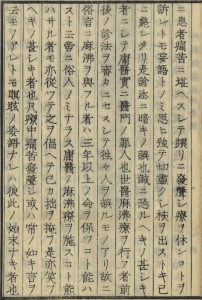 患者は痛みに耐えかね、声を発して手術の一時中断を訴えましたが、医師は、妄語とのみ思いこみ、強いて手術を続け、患部を取り出した時にはついに患者は死んでしまいました。これは、診察の知識の浅さゆえの誤りです。本当に恐るべきひどい医師で、医術界の罪人です。世の中の医師で、麻沸散を使い治療を行う医師のなかにも、麻沸湯投与の前後の診察を行わなかったばかりに患者に誤った治療をする医師がいます。そのため、麻沸散を投与された者は3年以上命を保つことができないと一部の人々に言われています。また、一般の人だけでなく、凡庸で麻沸散を十分に使いこなすことのできない医師もこのことを唱えて、自分の拙さを隠そうとしています。これもまた大いに笑うべきことです。概して、麻沸湯を使った治療中に苦痛に声を発したり、ふつうのように会話をしたりすることがありますが、これは麻酔下のうわごとなので、しかたのないものです。
患者は痛みに耐えかね、声を発して手術の一時中断を訴えましたが、医師は、妄語とのみ思いこみ、強いて手術を続け、患部を取り出した時にはついに患者は死んでしまいました。これは、診察の知識の浅さゆえの誤りです。本当に恐るべきひどい医師で、医術界の罪人です。世の中の医師で、麻沸散を使い治療を行う医師のなかにも、麻沸湯投与の前後の診察を行わなかったばかりに患者に誤った治療をする医師がいます。そのため、麻沸散を投与された者は3年以上命を保つことができないと一部の人々に言われています。また、一般の人だけでなく、凡庸で麻沸散を十分に使いこなすことのできない医師もこのことを唱えて、自分の拙さを隠そうとしています。これもまた大いに笑うべきことです。概して、麻沸湯を使った治療中に苦痛に声を発したり、ふつうのように会話をしたりすることがありますが、これは麻酔下のうわごとなので、しかたのないものです。
The patient, in excruciating pain, screamed and begged for the operation to be terminated. But the doctor regarded her complaints as mere nonsense of a deliriant under anesthesia, and kept proceeding with the surgery. By the time the tumor was resected, the unfortunate patient had passed away. This is a horrible mistake stemming from diagnostic incompetence of the doctor, and he, in my opinion, is a despisable doctor, a grave sinner of the medical society.
There are doctors, who use Mafutsuto yet don’t adequately perform the peri-anesthesia diagnoses, and thus make improper patient management. This has spawned a belief among some lay folks that the patients who receive Mafutsuto for their operation can’t live any longer than 3 years. Some doctors, who are incompetent in using Mafutsuto, argue for this belief, in an attempt not to recognize, or even to hide, their ignorance and incompetence. Such doctors deserve an utter contempt.
Patients under anesthesia often complain of agony, or some even make speeches as if in a fully awake state. In most cases, the statements those patients make are stemming from delirium, and don’t merit any responses.
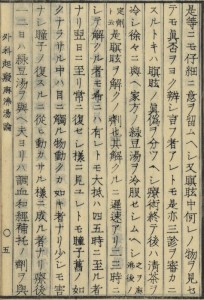 ただ、これらにも十分注意すべきです。また麻酔中にいろいろなものをみせてもきちんと答えられる患者もいますが、このような時は麻沸湯投与後の三診で確認することで麻酔の真偽を判断することができます。手術が終わった後は、清茶を冷やしてすこしずつ与え、家方の緑豆湯を冷たくして与えます。(これを麻沸湯投与後の通常の投薬といいます)これは麻酔を醒ます薬です。この醒め方に早い遅いがあります。4~6時間で醒める者も稀にはいますが、だいたいは8~10時間で醒めます。翌日になり、普通の状態に戻ったように見えても、瞳孔は普通の大きさに戻っていないので、眼に映るものが動きゆらめいているように見えますが、少しも害はありません。瞳孔が普通の大きさに戻れば動かなくなりもとに戻ります。手術後、1、2日は、緑豆湯を与え、その後は調血、和経、補托の薬を与え、
ただ、これらにも十分注意すべきです。また麻酔中にいろいろなものをみせてもきちんと答えられる患者もいますが、このような時は麻沸湯投与後の三診で確認することで麻酔の真偽を判断することができます。手術が終わった後は、清茶を冷やしてすこしずつ与え、家方の緑豆湯を冷たくして与えます。(これを麻沸湯投与後の通常の投薬といいます)これは麻酔を醒ます薬です。この醒め方に早い遅いがあります。4~6時間で醒める者も稀にはいますが、だいたいは8~10時間で醒めます。翌日になり、普通の状態に戻ったように見えても、瞳孔は普通の大きさに戻っていないので、眼に映るものが動きゆらめいているように見えますが、少しも害はありません。瞳孔が普通の大きさに戻れば動かなくなりもとに戻ります。手術後、1、2日は、緑豆湯を与え、その後は調血、和経、補托の薬を与え、
However, they still do deserve an attention. Some patients under anesthesia may exhibit a seemingly unimpaired cognitive function, and may be able to accurately describe the objects they are presented to. Even in such patients, adequacy of anesthesia can be assessed reliably by performing the three post-administration diagnoses.
After the completion of the operation, the patient should be given a cooled cup of tea by little amounts, followed by Ryokutouto (green-pea soup, believed to have antipyretic and diuretic effect), also cooled and by little amounts. They are designated as the standard emergence-medications. The emergence time varies among patients. There are few patients who only take 4~6 hours to emerge from anesthesia, but average time is between 8~10 hours. On the following day, a patient in an apparent fully awake state may complain about a vision problem, in which stationary objects appear to be moving. This is because his/her pupils are still dilated, and this does not warrant any concerns. Upon returning of the pupils to their normal sizes, the vision problem shall resolve. For the first two days following the operation, the patient should be kept on Ryokutouto, and after that, they should be given medications for Chouketsu (regulation of the circulation), Hotaku (anti-suppuration), etc.
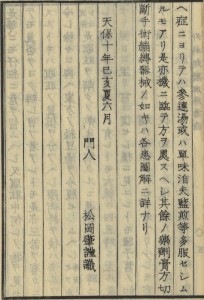 症状によっては、参連湯あるいはサフラン煎剤など多剤を服用させる場合もあります。その後もそれぞれの場合に臨んで適当な薬を処方すべきです。そのほか、薬剤、軟膏、切断手術の包帯や器械などはそれぞれの疾患の図解に詳しく書いてあります。
症状によっては、参連湯あるいはサフラン煎剤など多剤を服用させる場合もあります。その後もそれぞれの場合に臨んで適当な薬を処方すべきです。そのほか、薬剤、軟膏、切断手術の包帯や器械などはそれぞれの疾患の図解に詳しく書いてあります。
天保十年 己亥 夏六月 門人 松岡肇 謹識
Depending on the patient’s condition, use of Sanrento (an antipyretic), saffron-extract (believed to have anti-coagulative effect), and other agents should be considered. The patient management plan after the immediate post-operation period should be made based on evaluation of the condition of each patient. The types of equipments, medications, and surgical tools required for individual disease entities are detailed on their respective atlases.
